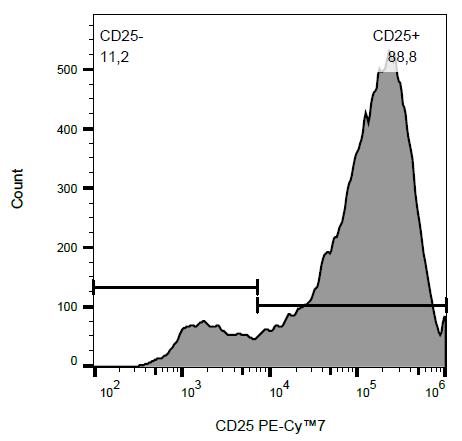Anti-CD25 / IL-2R alpha chain Monoclonal Antibody (Clone:MEM-181) PE-Cy™7 Conjugated

Fig1: Flow cytometry analysis (surface staining) of PHA-stimulated human PBMC with anti-human CD25 (MEM-181) PE-Cy™7.
Roll over image to zoom in
Shipping Info:
For estimated delivery dates, please contact us at [email protected]
| Amount : | 100 tests |
| Isotype : | Mouse IgG1 |
| Purification : | Purified antibody is conjugated with activated tandem dye of R-phycoerythrin-cyanine 7 (PE-Cy™7) under optimum conditions and unconjugated antibody and free fluorochrome are removed by size-exclusion chromatography. |
| Content : | Formulation : Stabilizing phosphate buffered saline (PBS), pH 7.4, 15 mM sodium azide |
| Storage condition : | Store at 2-8°C. Protect from prolonged exposure to light. Do not freeze. |
Specificity: The antibody MEM-181 reacts with an extracellular epitope of CD25 (Interleukin-2 receptor alpha chain), a 55 kDa type I transmembrane glycoprotein expressed on activated B and T lymphocytes, activated monocytes/macrophages and on CD4+ T lymphocytes (T regulatory cells); it is lost on resting B and T lymphocytes.
Description: CD25 (IL2Ralpha, Tac) is a ligand-binding alpha subunit of interleukin 2 receptor (IL2R). Together with beta and gamma subunit CD25 constitues the high affinity IL2R, whereas CD25 alone serves as the low affinity IL2R. CD25 expression rapidly increases upon T cell activation. The 55 kDa CD25 molecule is enzymatically cleaved and shed from the cell surface as a soluble 45 kDa s-Tac, whose concentration in serum can be used as a marker of T cell activation. Expression of CD25 indicates the neoplastic phenotype of mast cells. Humanized anti CD25 antibodies represent a useful tool to reduce the incidence of allograft rejection as well as the severity of graft versus host reaction, and radioimmunoconjugates of anti-CD25 antibodies can be used against CD25 expressing lymphomas.
Flow cytometry: The reagent is designed for analysis of human blood cells using 4 μl reagent / 100 μl of whole blood or 106 cells in a suspension. The content of a vial (0.4 ml) is sufficient for 100 tests.
For Research Use Only. Not for use in diagnostic/therapeutics procedures.
|
There are currently no product reviews
|












.png)












